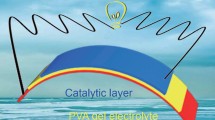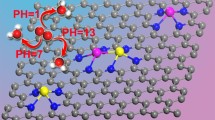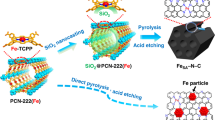Abstract
Non-precious metal catalysts (NPMCs) are promising low-cost alternatives of Pt/C for oxygen reduction reaction (ORR), which however suffer from serious stability challenge in the devices of proton-exchange-membrane fuel cells (PEMFC). Different from the traditional strategies of increasing the degree of graphitization of carbon substrates and using less Fenton-reactive metals, we prove here that proper regulation of coordination anions is also an effective way to improve the stability of NPMC. N/P co-coordinated Fe-Co dual-atomic-sites are constructed on ZIF-8 derived carbon support using a molecular precursor of C34H28Cl2CoFeP2 and a “precursor-preselected” method. A composition of FeCoN5P1 is infered for the dual-atom active site by microscopy and spectroscopy analysis. By comparing with N-coordinated references, we investigate the effect of P-coodination on the ORR catalysis of Fe-Co dual-atom catalysts in PEMFC. The metals in FeCoN5P1 have the lower formation energy than those in the solo N-coordinated active sites of FeCoN6 and FeN4, and exhibits a much better fuel cell stability. This anion approach provides a new way to improve the stability of dual-atom catalysts.

Similar content being viewed by others
References
Liu, S. Hydrogen storage in incompletely etched multilayer Ti2CTx at room temperature. Nat. Nanotech. 2021, 16, 331–336.
Wang, Y. Rational design of three-phase interfaces for electrocatalysis. Nano Res. 2019, 12, 2055–2066.
Wang, L. Fe-N-C catalysts for PEMFC: Progress towards the commercial application under DOE reference. J. Energy Chem. 2019, 39, 77–87.
Yang, C. Sulfur-anchoring synthesis of platinum intermetallic nanoparticle catalysts for fuel cells. Science 2021, 374, 459–464.
Sun, M. R.; Chen, C. L.; Wu, M. H.; Zhou, D. N.; Sun, Z. Y.; Fan, J. L.; Chen, W. X.; Li, Y. J. Rational design of Fe-N-C electrocatalysts for oxygen reduction reaction: From nanoparticles to single atoms. Nano Res., in press, DOI: https://doi.org/10.1007/s12274-021-3827-8.
Sun, T. Metal organic frameworks derived single atom catalysts for electrocatalytic energy conversion. Nano Res. 2019, 12, 2067–2080.
Li, J. Ultrahigh-loading zinc single-atom catalyst for highly efficient oxygen reduction in both acidic and alkaline media. Angew. Chem., Int. Ed. 2019, 58, 7035–7039.
Liu, Q. The solid-phase synthesis of an Fe-N-C electrocatalyst for high-power proton-exchange membrane fuel cells. Angew. Chem., Int. Ed. 2018, 57, 1204–1208.
Wang, X. Nitrogen-coordinated single cobalt atom catalysts for oxygen reduction in proton exchange membrane fuel cells. Adv. Mater. 2018, 30, 1706758.
Han, A. An adjacent atomic platinum site enables single-atom iron with high oxygen reduction reaction performance. Angew. Chem., Int. Ed. 2021, 60, 19262–19271.
Chen, Y. Atomic-level modulation of electronic density at cobalt single-atom sites derived from metal-organic frameworks: Enhanced oxygen reduction performance. Angew. Chem., Int. Ed. 2021, 60, 3212–3221.
Han, A. Carbon-supported single-atom catalysts for formic acid oxidation and oxygen reduction reactions. Small 2021, 17, 2004500.
Yang, J. Single-atom materials: Small structures determine macroproperties. Small Struct. 2021, 2, 2000051.
Chen, H. A facile route to fabricate double atom catalysts with controllable atomic spacing for the r-WGS reaction. J. Mater. Chem. A 2020, 8, 2364–2368.
Wei, Y. Fabricating dual-atom iron catalysts for efficient oxygen evolution reaction: A heteroatom modulator approach. Angew. Chem., Int. Ed. 2020, 59, 16013–16022.
Yan, H. Bottom-up precise synthesis of stable platinum dimers on graphene. Nat. Commun. 2017, 8, 1070.
Zhang, L. Coordination of atomic Co-Pt coupling species at carbon defects as active sites for oxygen reduction reaction. J. Am. Chem. Soc. 2018, 140, 10757–10763.
Ren, W. Isolated diatomic Ni-Fe metal-nitrogen sites for synergistic electroreduction of CO2. Angew. Chem., Int. Ed. 2019, 58, 6972–6976.
Yu, D. Dual-sites coordination engineering of single atom catalysts for flexible metal-air batteries. Adv. Energy Mater. 2021, 11, 2101242.
Zhang, W. Emerging dual-atomic-site catalysts for efficient energy catalysis. Adv. Mater. 2021, 33, 2102576.
Chen, L. Synergistic effect between atomically dispersed Fe and Co metal sites for enhanced oxygen reduction reaction. J. Mater. Chem. A 2020, 8, 4369–4375.
Tong, M. Operando cooperated catalytic mechanism of atomically dispersed Cu-N4 and Zn-N4 for promoting oxygen reduction reaction. Angew. Chem., Int. Ed. 2021, 60, 14005–14012.
Xu, J. Atomic Fe-Zn dual-metal sites for high-efficiency pH-universal oxygen reduction catalysis. Nano Res. 2021, 14, 1374–1381.
Liu, J. Hydrogen passivation of M-N-C (M = Fe, Co) catalysts for storage stability and ORR activity improvements. Adv. Mater. 2021, 33, 2103600.
Wan, X. Stability of PGM-free fuel cell catalysts: Degradation mechanisms and mitigation strategies. Prog. Nat. Sci.: Mater. Int. 2020, 30, 721–731.
Qiao, Z. 3D porous graphitic nanocarbon for enhancing the performance and durability of Pt catalysts: A balance between graphitization and hierarchical porosity. Energy Environ. Sci. 2019, 12, 2830–2841.
Gupta, S. Highly active and stable graphene tubes decorated with FeCoNi alloy nanoparticles via a template-free graphitization for bifunctional oxygen reduction and evolution. Adv. Energy Mater. 2016, 6, 1601198.
Li, J. Atomically dispersed manganese catalysts for oxygen reduction in proton-exchange membrane fuel cells. Nat. Catal. 2018, 1, 935–945.
Xie, X. Performance enhancement and degradation mechanism identification of a single-atom Co-N-C catalyst for proton exchange membrane fuel cells. Nat. Catal. 2020, 3, 1044–1054.
Luo, E. Single-atom Cr-N4 sites designed for durable oxygen reduction catalysis in acid media. Angew. Chem., Int. Ed. 2019, 58, 12469–12475.
Zhu, X. Intrinsic ORR activity enhancement of Pt atomic sites by engineering the d-band center via local coordination tuning. Angew. Chem., Int. Ed. 2021, 60, 21911–21917.
Liu, Q. Sequential synthesis and active-site coordination principle of precious metal single-atom catalysts for oxygen reduction reaction and PEM fuel cells. Adv. Energy Mater. 2020, 10, 2000689.
Li, X. Modulating the local coordination environment of single-atom catalysts for enhanced catalytic performance. Nano Res. 2020, 13, 1842–1855.
Wang, Y.; Zheng, X. B.; Wang, D. S. Design concept for electrocatalysts. Nano Res., in press, DOI: https://doi.org/10.1007/s12274-021-3794-0.
Li, J. Boosting the activity of Fe-Nx. moieties in Fe-N-C electrocatalysts via phosphorus doping for oxygen reduction reaction. Sci. China Mater. 2020, 63, 965–971.
Li, Y. Atomically dispersed Fe-N-P-C complex electrocatalysts for superior oxygen reduction. Appl. Catal. B: Environ. 2019, 249, 306–315.
Zhu, X. P co-coordinated Fe species embedded in carbon hollow spheres for oxygen electrocatalysis. J. Mater. Chem. A 2019, 7, 14732–14742.
Wu, G. High-performance electrocatalysts for oxygen reduction derived from polyaniline, iron, and cobalt. Science 2011, 332, 443–447.
Bai, L. A cobalt-iron double-atom catalyst for the oxygen evolution reaction. J. Am. Chem. Soc. 2019, 141, 14190–14199.
Han, X. Atomically dispersed binary Co-Ni sites in nitrogen-doped hollow carbon nanocubes for reversible oxygen reduction and evolution. Adv. Mater. 2019, 31, 1905622.
Lu, Z. An isolated zinc-cobalt atomic pair for highly active and durable oxygen reduction. Angew. Chem., Int. Ed. 2019, 58, 2622–2626.
Wang, J. Design of N-coordinated dual-metal sites: A stable and active Pt-free catalyst for acidic oxygen reduction reaction. J. Am. Chem. Soc. 2017, 139, 17281–17284.
Xiao, M. Climbing the apex of the ORR volcano plot via binuclear site construction: Electronic and geometric engineering. J. Am. Chem. Soc. 2019, 141, 17763–17770.
Wang, J. Synergistic effect of well-defined dual sites boosting the oxygen reduction reaction. Energy Environ. Sci. 2018, 17, 3375–3379.
Zhang, G. A general route via formamide condensation to prepare atomically dispersed metal-nitrogen-carbon electrocatalysts for energy technologies. Energy Environ. Sci. 2019, 12, 1317–1325.
Wang, K. Establishing structure/property relationships in atomically dispersed Co-Fe dual site M-Nx catalysts on microporous carbon for the oxygen reduction reaction. J. Mater. Chem. A 2021, 9, 13044–13055.
Tian, S. Carbon nitride supported Fe2 cluster catalysts with superior performance for alkene epoxidation. Nat. Commun. 2018, 9, 2353.
Newville, M. IFEFFIT: Interactive XAFS analysis and FEFF fitting. J. Synchrotron Rad. 2001, 8, 322–324.
Grimme, S. Semiempirical GGA-type density functional constructed with a long-range dispersion correction. J. Comput. Chem. 2006, 27, 1787–1799.
Kresse, G. Efficiency of ab-initio total energy calculations for metals and semiconductors using a plane-wave basis set. Comput. Mater. Sci. 1996, 6, 15–50.
Kresse, G. Efficient iterative schemes for ab initio total-energy calculations using a plane-wave basis set. Phys. Rev. B: Condens. Matter 1996, 54, 11169–11186.
Kresse, G. From ultrasoft pseudopotentials to the projector augmented-wave method. Phys. Rev. B 1999, 59, 1758–1775.
Perdew, J. Generalized gradient approximation made simple. Phys. Rev. Lett. 1996, 77, 3865–3868.
Kattel, S. Stability, electronic and magnetic properties of in-plane defects in graphene: A first-principles study. J. Phys. Chem. C 2012, 116, 8161–8166.
Wan, X. Fe-N-C electrocatalyst with dense active sites and efficient mass transport for high-performance proton exchange membrane fuel cells. Nat. Catal. 2019, 2, 259–268.
Ding, R. Facile grafting strategy synthesis of single-atom electrocatalyst with enhanced ORR performance. Nano Res. 2020, 13, 1519–1526.
Tang, W. Boosting electrocatalytic water splitting via metalmetalloid combined modulation in quaternary Ni-Fe-P-B amorphous compound. Nano Res. 2020, 13, 447–454.
Stakheev, A. Formation of small rhodium metal particles on the surface of a carbon support. Kinet. Catal. 2005, 46, 114–122.
Liu, J. Rare earth single-atom catalysts for nitrogen and carbon dioxide reduction. ACS Nano 2020, 14, 1093–1101.
Ye, W. Precisely tuning the number of Fe atoms in clusters on N-doped carbon toward acidic oxygen reduction reaction. Chem 2019, 5, 2865–2878.
Guo, S. Atomic-scaled cobalt encapsulated in P, N-doped carbon sheaths over carbon nanotubes for enhanced oxygen reduction electrocatalysis under acidic and alkaline media. Chem. Commun. 2017, 53, 9862–9865.
Jin, H. P-Fe bond oxygen reduction catalysts toward high-efficiency metal-air batteries and fuel cells. J. Mater. Chem. A 2020, 8, 9121–9127.
Yuan, K. Boosting oxygen reduction of single iron active sites via geometric and electronic engineering: Nitrogen and phosphorus dual coordination. J. Am. Chem. Soc. 2020, 142, 2404–2412.
Chenitz, R. A specific demetalation of Fe-N4 catalytic sites in the micropores of NC_Ar + NH3 is at the origin of the initial activity loss of the highly active Fe/N/C catalyst used for the reduction of oxygen in PEM fuel cells. Energy Environ. Sci. 2018, 11, 365–382.
Li, Y. Preparation of Fe-N-C catalysts with FeNx (x = 1, 3, 4) active sites and comparison of their activities for the oxygen reduction reaction and performances in proton exchange membrane fuel cells. J. Mater. Chem. A 2019, 7, 26147–26153.
Xue, L. Zigzag carbon as efficient and stable oxygen reduction electrocatalyst for proton exchange membrane fuel cells. Nat. Commun. 2018, 9, 3819.
Li, Y. Effect of Zn atom in Fe-N-C catalysts for electro-catalytic reactions: Theoretical considerations. Nano Res. 2021, 14, 611–619.
Xu, H. A universal principle for a rational design of single-atom electrocatalysts. Nat. Catal. 2018, 1, 339–348.
Hu, B. Atomic Co/Ni dual sites with N/P-coordination as bifunctional oxygen electrocatalyst for rechargeable zinc-air batteries. Nano Res. 2021, 14, 3482–3488.
Acknowledgements
This work was supported by Natural Science Foundation of Beijing Municipality (No. Z200012) and the National Natural Science Foundation of China (No. 21975010).
Author information
Authors and Affiliations
Corresponding author
Electronic Supplementary Material
12274_2021_3966_MOESM1_ESM.pdf
Catalysis stability enhancement of Fe/Co dual-atom site via phosphorus coordination for proton exchange membrane fuel cell
Rights and permissions
About this article
Cite this article
Wang, Y., Wan, X., Liu, J. et al. Catalysis stability enhancement of Fe/Co dual-atom site via phosphorus coordination for proton exchange membrane fuel cell. Nano Res. 15, 3082–3089 (2022). https://doi.org/10.1007/s12274-021-3966-y
Received:
Revised:
Accepted:
Published:
Issue Date:
DOI: https://doi.org/10.1007/s12274-021-3966-y




